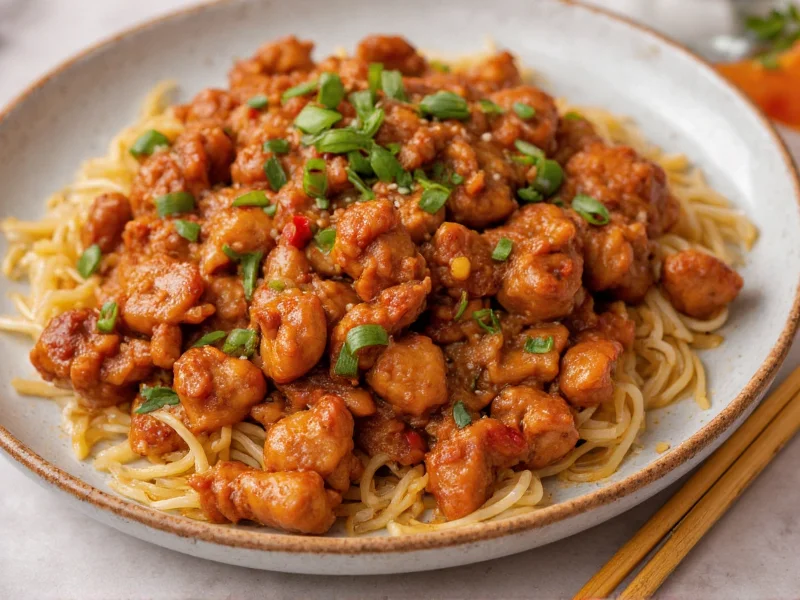Hunan chicken represents one of China's spiciest regional cuisines, originating from湖南province's humid climate where bold flavors help preserve food and stimulate appetite. The distinctive taste comes from generous amounts of fresh red chilies, particularly the locally grown facing heaven chili (朝天椒), which provides intense but short-lived heat without the numbing effect found in Szechuan cuisine. Authentic Hunan chicken balances this fiery element with sharp vinegar notes, creating a flavor profile that's simultaneously spicy, sour, and fragrant.
Breaking Down the Hunan Chicken Flavor Profile
Understanding what does Hunan chicken taste like requires examining its four signature elements:
- Immediate Spiciness - Fresh chilies deliver direct heat that hits quickly but fades faster than dried chili heat
- Tangy Sourness - Black vinegar or pickled vegetables add brightness that cuts through richness
- Aromatic Base - Generous garlic, ginger, and scallions create foundational fragrance
- Minimal Sweetness - Unlike Americanized versions, authentic Hunan chicken contains little to no sugar
The magic of Hunan chicken taste lies in how these elements interact. The vinegar's acidity actually enhances the perception of spiciness while preventing the heat from becoming overwhelming. This creates what Chinese chefs call "fresh heat" (鲜辣) - a clean, invigorating spiciness that stimulates rather than numbs the palate.
Hunan Chicken vs Szechuan Chicken: Understanding the Taste Differences
Many diners confuse Hunan and Szechuan chicken, but their flavor profiles differ significantly. This comparison clarifies authentic Hunan chicken flavor profile versus its more famous cousin:
| Characteristic | Hunan Chicken | Szechuan Chicken |
|---|---|---|
| Primary Heat Source | Fresh red chilies | Dried chilies + Szechuan peppercorns |
| Heat Quality | Direct, immediate burn | Numbing ma la sensation |
| Sour Element | Prominent vinegar notes | Minimal sourness |
| Sweetness | Nearly absent | Noticeable sugar/honey |
| Aromatic Profile | Garlic-forward, fresh | Toasted spice complexity |
| Sauce Texture | Lighter, more broth-like | Thicker, oil-based |
Key Ingredients That Define Authentic Hunan Chicken Flavor
The distinctive Hunan chicken taste comes from specific ingredients rarely substituted in traditional preparations:
- Facing Heaven Chilies - These small, potent fresh chilies provide the signature bright red color and immediate heat without excessive oiliness
- Chen Vinegar - A aged black vinegar from Zhenjiang that adds complex sourness without harsh acidity
- Wild Mountain Garlic - Hunan's native garlic variety with sharper, more pungent flavor than common supermarket garlic
- Fermented Black Beans - Used sparingly to add umami depth without overpowering the fresh chili flavor
- Local Bamboo Shoots - Fresh or pickled, these add textural contrast and subtle sour notes
Unlike Westernized versions of Hunan chicken that often include sugar, honey, or heavy cornstarch, authentic preparations maintain ingredient purity. The cooking technique matters as much as ingredients - traditional stir-frying over extremely high heat preserves the fresh chili flavor while preventing bitterness.
Regional Variations Within Hunan Province
Even within Hunan province, the chicken taste profile varies by region:
- Xiangtan area - Features stronger vinegar notes and more pickled vegetables
- Changsha (provincial capital) - Balanced approach with moderate heat and pronounced garlic
- Western Hunan mountain regions - Uses smoked meats and more dried chilies due to preservation needs
- Dongting Lake area - Incorporates freshwater fish sauce for umami complexity
These regional differences explain why some Hunan chicken dishes taste more sour while others emphasize garlic or feature subtle smokiness. Understanding these variations helps identify truly authentic Hunan chicken flavor profile versus generic "spicy Chinese chicken" dishes.
How Cooking Technique Affects Hunan Chicken Taste
The distinctive Hunan chicken taste relies on specific preparation methods:
- Velveting - Chicken is briefly marinated in egg white and cornstarch before quick frying, creating tender texture that absorbs flavors without becoming greasy
- Single-Wok Cooking - All ingredients cook sequentially in the same wok, building layered flavors while maintaining ingredient separation
- Vinegar Timing - Added late in cooking to preserve bright acidity rather than mellowing into sweetness
- Chili Preparation - Fresh chilies are stir-fried whole to release oils without burning
These techniques preserve the fresh, vibrant quality that defines what Hunan chicken tastes like. When restaurants substitute dried chilies or add sugar, they fundamentally alter the dish's character, creating something closer to Szechuan or generic American-Chinese cuisine.
Common Misconceptions About Hunan Chicken Flavor
Several myths persist about Hunan chicken taste that obscure its authentic profile:
- "Hunan is just spicier Szechuan" - Incorrect. The heat profiles differ fundamentally (fresh vs dried chilies, no numbing peppercorns)
- "All Hunan food is extremely spicy" - While spicy, authentic versions balance heat with sourness that makes it more palatable
- "Hunan chicken contains peanuts" - Peanuts appear in some Szechuan dishes but rarely in authentic Hunan preparations
- "Hunan sauce is thick and sticky" - Authentic versions have lighter consistency, closer to a seasoned broth
Recognizing these distinctions helps identify genuine Hunan chicken flavor profile when dining out or attempting homemade versions. The dish's appeal lies in its clean, refreshing heat that enhances rather than overwhelms the chicken's natural flavor.
Perfect Pairings for Hunan Chicken's Distinctive Taste
The bold Hunan chicken taste profile pairs well with specific accompaniments that complement rather than compete with its flavor characteristics:
- Steamed Jasmine Rice - Neutral base that absorbs sauce while cooling the palate
- Stir-Fried Chinese Broccoli - Bitter greens balance the dish's heat and acidity
- Cucumber Salad with Garlic - Cool, crisp contrast to the spicy chicken
- Jasmine Tea - Floral notes refresh the palate between bites
- Light Lagers - Crisp beers cut through heat better than heavy ales
Avoid pairing Hunan chicken with overly sweet sides or rich sauces that would conflict with its clean, acidic profile. The goal is enhancing the dish's natural vibrancy rather than masking its distinctive taste.











 浙公网安备
33010002000092号
浙公网安备
33010002000092号 浙B2-20120091-4
浙B2-20120091-4